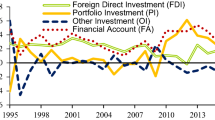Abstract
It has been suggested that Mexican investors were the “front-runners” in the peso crisis of December 1994, turning pessimistic before international investors. Different expectations about their own economy, perhaps due to asymmetric information, prompted Mexican investors to be the first ones to leave the country. This paper investigates whether data from three Mexican country funds provide evidence that supports the “divergent expectations” hypothesis. We find that, right before the devaluation, Mexican fund Net Asset Values (mainly driven by Mexican investors) dropped first and/or faster than Mexican country fund prices (mainly driven by foreign investors). Moreover, we find that Mexican NAVs tend to Granger-cause the country fund prices. This suggests that causality, in some sense, flows from the Mexico City investor community to the Wall Street investor community.
Similar content being viewed by others
References
Banerjee, Anindya, Juan Dolado, John W. Galbraith, and David F. Hendry. (1994). Co-Integration, Error-Correction, and the Econometric Analysis of Non-Stationary Data,Oxford University Press.
Calvo, Guillermo, Leonardo Leiderman and Carmen Reinhart. (1993). “Capital Inflows and Real Exchange Rate Appreciation in Latin America: the Role of External Factors”,IMF Staff Papers 40(1), 108–150.
Chuhan, Punam, Stijn Claessens, and Nlandu Mamingi. (1994). “Equity and Bond Flows to Latin America and Asia: the Role of Global and Country,” unpublished manuscript,The World Bank.
Diwan, Ishac, Vihang Errunza, and Lemma Senbet. (1993). “Country Funds For Emerging Economies,” in Stijn Claenssens and Sudarshan Gooptu (eds.) Portfolio Investment in Developing Countries,Washington:The World Bank.
Diwan, Ishac, Vihang Errunza, and Lemma Senbet. (1994). “Diversification benefits of country funds,” in Investing in Emerging Markets,Euromoney Books and The Worl Bank.
Dooley, Michael, Eduardo Fernandez-Arias and Kenneth Kletzer. (1994). “Recent Private Capital Inflows to Developing Countries: Is the Debt Crisis History?,”National Bureau of Economic Research Working Paper No.4792, July.
Errunza, Vihang R. (1991). “Pricing of National Index Funds”,Review of Quantitative Finance and Accounting, pp. 91–100.
Fernandez-Arias, Eduardo. (1994). “The New Wave of Private Capital Inflows: Push or Pull?,”Policy Research Working Paper 1312, Debt and International Finance Division, International Economics Department,The World Bank, June.
Frankel, Jeffrey A. (1994a). “Introduction” to the Internationalization of Equity Markets, theUniversity of Chicago Press, Chicago, 1994.
Frankel, Jeffrey A. (1994b). “Sterilization of Money Inflows: Difficult (Calvo) or Easy (Reisen)?” in Afluencia de Capitales y Estabilizacion en America Latina, edited by Roberto Steiner,Fedesarrollo, Bogota, pp. 241–267.
Hardouvelis, Gikas A., Rafael La Porta, and Thierry A. Wizman. (1994). “What Moves the Discount on Country Equity Funds?,”National Bureau of Economic Research Working Paper 4571, in J. Frankel, ed., The Internationalization of Equity Markets, theUniversity of Chicago Press, Chicago.
International Monetary Fund. (1995). International Capital Markets, Developments, Prospects, and Policy Issues, August.
Kramer, Charles, and R. Todd Smith. (1995). “Recent Turmoil in Emerging Markets and the Behavior of Country-Fund Discounts: Removing the Puzzle of the Pricing of Closed-End Mutual Funds,”International Monetary Fund Working Paper 95/68, July.
Lee Charles, M. C., Andrei Shleiffer, and Richard Thaler. (1991). “Investor Sentiment and the Closed-end Fund Puzzle,”Journal of Finance, Vol. 46, No. 1, pp. 75–109.
Schadler, Susan, Maria Carkovic, Adam Bennett and Robert Kahn. (1993). “Recent Experiences with Surges in Capital Inflows”,Occasional Paper 108, International Monetary Fund.
Schmukler, Sergio. (1996). “Country Funds and Asymmetric Information,” unpublished manuscript,University of California at Berkeley.
Schmukler, Sergio and Jeffrey Frankel. (1996). “Crisis, Contagion, and Country Funds,” unpublished manuscript,University of California at Berkeley.
Stock, James H. and Mark W. Watson. (1993). “A Simple Estimator of Cointegrating Vectors in Higher Order Integrated Systems,”Econometrica 61, 783–820.
Vanguard Group. (1995).Plain Talk, “About Investing in Emerging Markets,” bulletin.
Author information
Authors and Affiliations
Rights and permissions
About this article
Cite this article
Frankel, J.A., Schmukler, S.L. Country fund discounts and the mexican crisis of December 1994: Did local residents turn pessimistic before international investors?. Open Econ Rev 7 (Suppl 1), 511–534 (1996). https://doi.org/10.1007/BF01886211
Issue Date:
DOI: https://doi.org/10.1007/BF01886211




